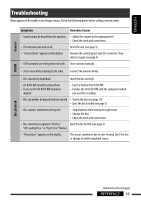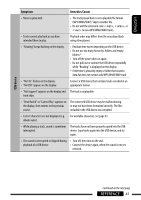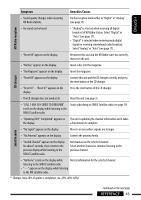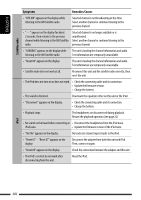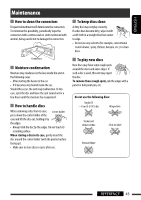JVC KD PDR80 Instructions - Page 41
Symptoms, Remedies/Causes, USB device
 |
UPC - 046838032943
View all JVC KD PDR80 manuals
Add to My Manuals
Save this manual to your list of manuals |
Page 41 highlights
USB device ENGLISH Symptoms Remedies/Causes • Noise is generated. • The track played back is not a playable file format (MP3/WMA/WAV). Skip to another file. • Do not add the extension code , , or to non-MP3/WMA/WAV tracks. • Tracks cannot play back as you have intended them to play. Playback order may differs from the one played back using other players. • "Reading" keeps flashing on the display. • Readout time varies depending on the USB device. • Do not use too many hierarchy, folders and empty folders.* • Turn off the power then on again. • Do not pull out or connect the USB device repeatedly while "Reading" is displayed on the display. * Folder that is phisically empty or folder that contains data but does not contain valid MP3/WMA/WAV track. • "No File" flashes on the display. • "No USB" appears on the display. Connect a USB device that contains tracks encoded in an appropriate format. • "Not Support" appears on the display and The track is unplayable. track skips. • "Read Failed" or "Cannot Play" appears on The connected USB device may be malfunctioning, the display, then returns to the previous or may not have been formatted correctly. The files source. included in the USB device are corrupted. • Correct characters are not displayed (e.g. For available characters, see page 33. album name). • While playing a track, sound is sometimes The tracks have not been properly copied into the USB interrupted. device. Copy tracks again into the USB device, and try again. • The sound is interrupted or skipped during • Turn off, then turn on the unit. playback of a USB device. • Connect the device again, when the sound is not yet restored. Continued on the next page REFERENCE 41






